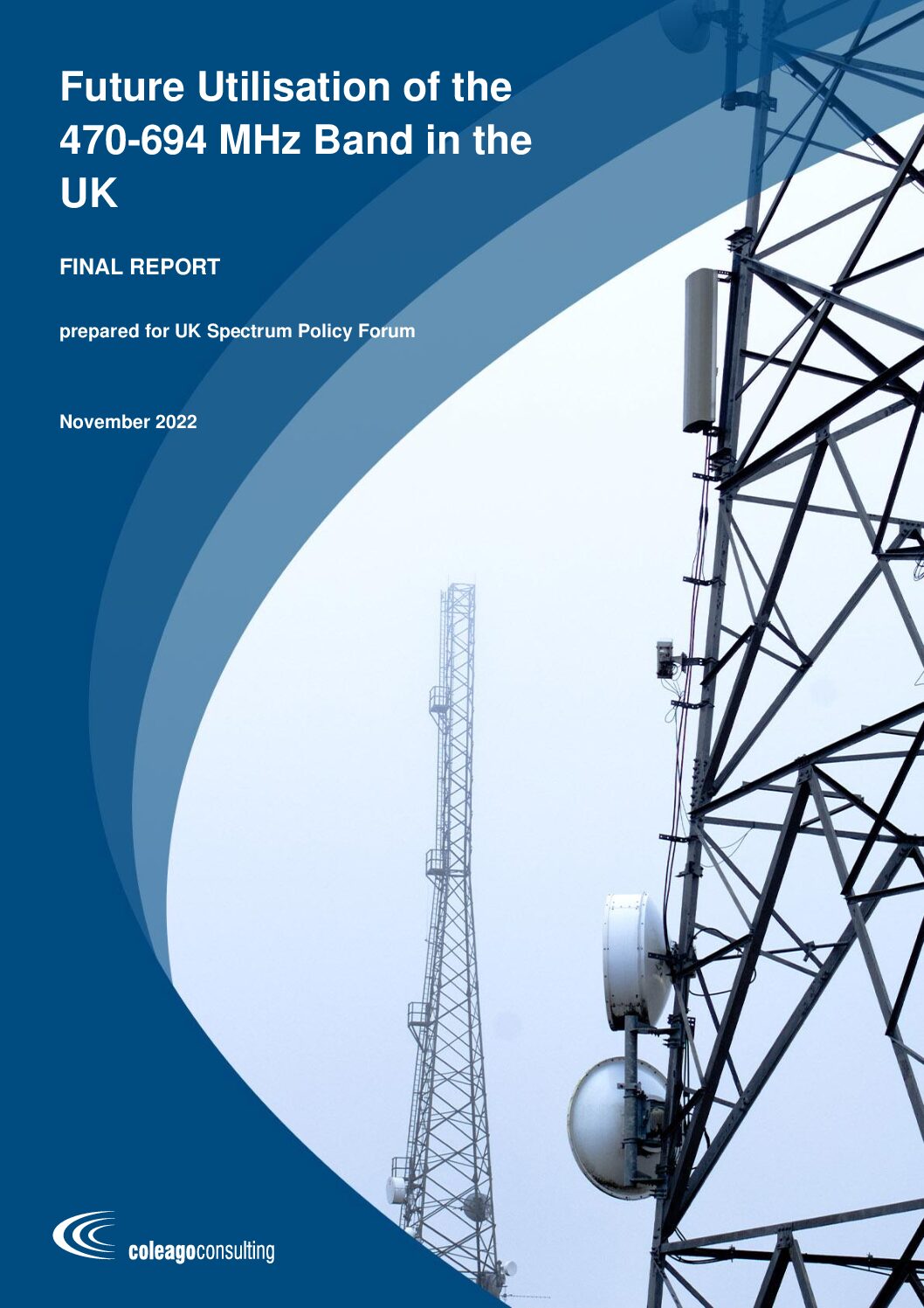Future Utilisation of the 470-694 MHz Band in the UK
In this report, written for the UK Spectrum Policy Forum ahead of WRC-23, Coleago explores the future use of the 470-694 MHz UHF band in the United Kingdom post 2030. The band is sought after and used by a wide range of services, including digital terrestrial television (DTT), programme-making and special events (PMSE) and mobile services amongst others.
Spectrum, a crucial national resource for the UK, presents economic and societal benefits. Its management requires periodic review to align with evolving technology and market dynamics. The forthcoming ITU WRC-23 Agenda Item 1.5 will assess the future use of the 470-694 MHz band in Region 1, emphasising potential shifts from traditional broadcasting to newer applications like mobile communications.

This commissioned report by the UK Spectrum Policy Forum explores post-2030 scenarios for the 470-694 MHz band. Key drivers of change in UHF spectrum use include the decline of linear TV, escalating mobile spectrum demand for 5G, continual growth in PMSE (Programme Making and Special Events) equipment use, and the convergence of mobile and broadcasting.
Four main scenarios are identified
Status Quo: No change in allocation. Linear TV declines modestly, mobile broadband demand grows steadily, and PMSE sees moderate growth.
Flexible Use: Co-primary allocation for broadcast and mobile services. Linear TV dwindles, and there’s support for 5G Broadcast internationally.
IMT600 Band Plan: Split allocation between broadcast and mobile services. Linear TV declines, but the band is divided into ranges for broadcast and mobile, accommodating specific bandwidths for each.
Transition to IPTV: Significant growth in mobile data demand due to a strong economic rebound. Linear TV decreases substantially, and a hybrid allocation between broadcast and mobile is proposed.
Efforts to enhance spectral efficiency and accommodate evolving user needs are emphasised across scenarios, urging stakeholders to optimise UHF spectrum use for broader societal benefits.
Related insights
Looking to the future
Challenges and opportunities arise in leveraging technology advancements, especially in DTT platforms and MNO spectrum allocations. The potential for interference between DTT and mobile services is noted, requiring bilateral agreements and coordination among countries.
The report highlights the potential for spectrum sharing between PMSE and IMT and recognises the need for a balanced approach to manage scarce UHF spectrum. It acknowledges that accommodating all stakeholders simultaneously might not be feasible, necessitating compromises, such as spectrum sharing.
The influence of international developments, especially decisions at World Radio Conferences (WRCs), will shape future UHF spectrum use. The report aims to contribute constructively to discussions by presenting scenarios and areas warranting further research.
While the report delves into specific outcomes concerning broadcasting and mobile coexistence, it acknowledges the need for broader regulatory assessments, which could be the focus of future studies.
Overall, the report serves as a comprehensive assessment of potential scenarios and their implications for the UK’s UHF spectrum use, emphasising the need for balanced decisions amidst evolving technological and market landscapes.
Other insights

The European 5G Fairytale
For years, European policymakers and telecom operators have touted the impressive figure: “89% 5G coverage of populated areas.” On paper, this paints a picture of near-ubiquitous, high-speed connectivity. Scratch the surface however, and the reality looks quite different.

Maximising Shareholder Value in Spectrum Auctions
Spectrum auctions, while common in the telecom industry, are complex and high-risk events that can significantly influence a company’s long-term performance. Missteps, especially vague auction objectives and poor valuation discipline, can lead to substantial destruction of shareholder value.

Spectrum and Regulatory Challenges Related to eVTOLS
Electric Vertical Take-Off and Landing (eVTOL) aircraft are poised to revolutionise urban mobility, with commercial operations expected to begin as early as 2025 and significant growth anticipated by the 2030s.

Future of the UHF Band after 2024: An Analysis of Options in the UK
Coleago Consulting in collaboration with its client, the UK Spectrum Policy Forum, has released a landmark report, “Future of the UHF Band After 2034,” setting out a detailed assessment of the United Kingdom’s Ultra High Frequency (UHF) spectrum landscape. The report looks at the industry trends and the critical trade-offs required to balance the needs of Digital Terrestrial Television (DTT), Mobile Communications, and Programme Making and Special Events (PMSE).

The Polish 700 and 800 MHz Spectrum Auction: Insights and Global Lessons
Poland’s final low-band spectrum auction marks a pivotal moment in Europe’s 5G rollout, offering key lessons in auction design, cross-border coordination, and strategic spectrum management.

The Case for Strategic Spectrum Renewal
As spectrum licences approach their expiry date, a strategic approach to spectrum renewal is crucial. Traditional presumption of renewal in favour of incumbents may no longer serve the industry’s needs. Instead, a more strategic approach to renewal can optimise spectrum assignments and improve spectral efficiency by up to 40%.